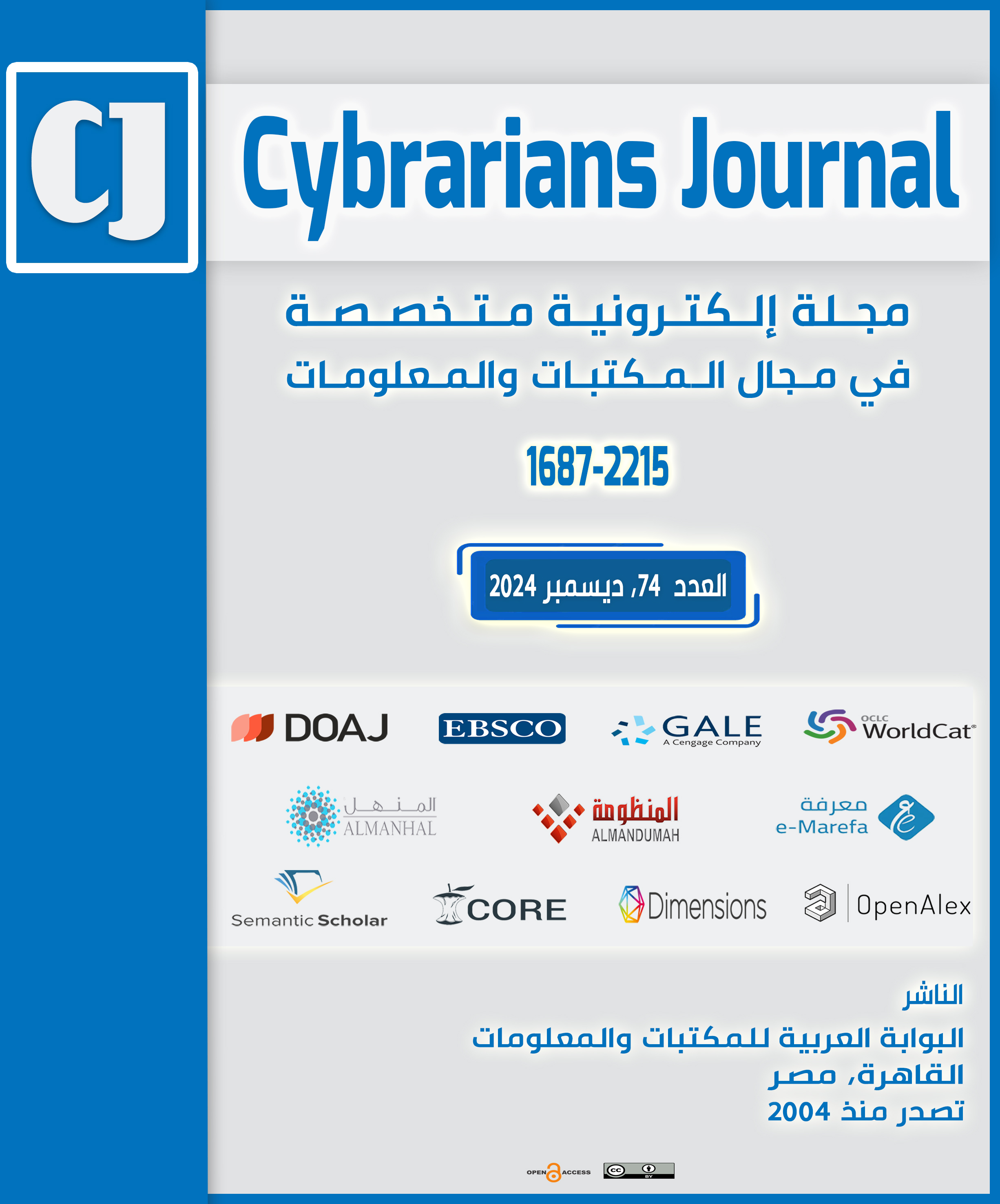برمجيات تحليل المشاعر مفتوحة المصدر: دراسة تقييمية للوظائف والإمكانات
DOI:
https://doi.org/10.70000/cj.2024.74.609الكلمات المفتاحية:
تحليل المشاعر، البرمجيات مفتوحة المصدر، استخراج البيانات، التنقيب عن الآراء، منصات التواصل الاجتماعي، اللغات الطبيعيةالملخص
تُعد برمجيات تحليل المشاعر مفتوحة المصدر وسيلة قوية لفهم المشاعر، والآراء؛ لتحسين الخدمات والمنتجات، ويمكن لجميع المؤسسات الاستفادة من هذه الأدوات؛ للحصول على نظرة ثاقبة، واتخاذ قرارات مستنيرة بناءً على تحليل البيانات من أجل تطوير الخدمات أو المنتجات؛ لتلبية احتياجات العملاء؛ حيث أصبحت البيانات بمثابة ثروة هائلة للمؤسسات، ومن أهم البيانات آراء العملاء، وتعليقاتهم. وأصبح الاهتمام بأساليب تحليل المشاعر أكثر أهمية مع ازدياد انتشار مواقع التواصل الاجتماعي، فمن خلال تلك المنصات، يُتيح المستخدمون آراءهم ويُشاركونها بحرية، ممّا يجعلها مصدرًا غنيًا للمعلومات حول المشاعر العامة تجاه مختلف القضايا والموضوعات؛ ونتيجة لذلك ظهرت العديد من البرامج الآلية التي تقوم بتحليل المشاعر، لفهم اتجاهات الرأي العام، وبهدف تحسين المنتجات والخدمات للخروج بصورة متكاملة، ولدعم اتخاذ القرار. ومن هذا المنطلق تتناول هذه الدراسة إجراء تقييم، ومقارنة تحليلية لتلك البرمجيات لمعرفة الفروق بين تلك البرمجيات من حيث ميزاتها، وتقييم الإمكانات المتاحة. حيث تم إجراء مقارنة تحليلية لـ38 برمجية من برمجيات تحليل المشاعر مفتوحة المصدر، وتبين أن برمجية (AssemblyAi ) هي أفضل البرمجيات، حيث تأتي في المرتبة الأولي وفقاً لمعايير التقييم المطروحة.
المراجع
‘Abd al-Hādī, Muḥammad Fatḥī. (2003). Al-baḥth wa-manāhijuhu fī ‘ilm al-maktabāt wa-al-ma‘lūmāt. Al-Qāhira: al-Dār al-Miṣriyya al-Lubnāniyya, p. 141.
Ahmed, A. A. A., Agarwal, S., Kurniawan, I. G. A., Anantadjaya, S. P., & Krishnan, C. (2022). Business boosting through sentiment analysis using Artificial Intelligence approach. International Journal of System Assurance Engineering and Management, 13(Suppl 1), 699-709
Al Shamsi, A. A., & Abdallah, S. (2021). Text mining techniques for sentiment analysis of Arabic dialects: Literature review. Adv. Sci. Technol. Eng. Syst. J, 6(1), 1012-1023.P.1012
Bird, S., Klein, E., & Loper, E. (2009). Natural language processing with Python: analyzing text with the natural language toolkit. " O'Reilly Media, Inc.".
Cieliebak, M., Dürr, O., & Uzdilli, F. (2013, December). Potential and Limitations of Commercial Sentiment Detection Tools. In ESSEM@ AI* IA (pp. 47-58).P.2
Devika, M. D., Sunitha, C., & Ganesh, A. (2016). Sentiment analysis: a comparative study on different approaches. Procedia Computer Science, 87, 44-49.p.44-48
El-Masri, M., Altrabsheh, N., & Mansour, H. (2017). Successes and challenges of Arabic sentiment analysis research: a literature review. Social Network Analysis and Mining, 7, 1-22.P.1
El-Masri, M., Altrabsheh, N., Mansour, H., & Ramsay, A. (2017). A web-based tool for Arabic sentiment analysis. Procedia Computer Science, 117, 38-45.P.38
Georgiou, D., MacFarlane, A., & Russell-Rose, T. (2015, July). Extracting sentiment from healthcare survey data: An evaluation of sentiment analysis tools. In 2015 Science and Information Conference (SAI) (pp. 352-361). IEEE
Georgiou, D., MacFarlane, A., & Russell-Rose, T. (2015, July). Extracting sentiment from healthcare survey data: An evaluation of sentiment analysis tools. In 2015 Science and Information Conference (SAI) (pp. 352-361). IEEE.P.1
Gonçalves, P., Araújo, M., Benevenuto, F., & Cha, M. (2013, October). Comparing and combining sentiment analysis methods. In Proceedings of the first ACM conference on Online social networks (pp. 27-38).P.27
Gupta, Y., & Kumar, P. (2017). Casas: Customized automated sentiment analysis system. JIMS8I-International Journal of Information Communication and Computing Technology, 5(1), 275-279.P.276
Hutto, C., & Gilbert, E. (2014, May). Vader: A parsimonious rule-based model for sentiment analysis of social media text. In Proceedings of the international AAAI conference on web and social media (Vol. 8, No. 1, pp. 216-225).P.217
Ibrāhīm, Randa Ibrāhīm. (2001). Ma‘āyīr ikhtiyār al-nuẓum al-muḥawwasa al-mutaqāmila fī al-maktabāt: dirāsa masḥiyya ‘alā al-maktabāt al-jāmi‘iyya al-Miṣriyya ma‘a dirāsa ḥāla ‘alā maktabāt Jāmi‘at Ḥilwān. Uṭrūḥa (Doctorate) - Jāmi‘at Ḥilwān, Kullīyat al-Ādāb - Qism al-Maktabāt, p. 48.
Kirilenko, A. P., Stepchenkova, S. O., Kim, H., & Li, X. (2018). Automated sentiment analysis in tourism: Comparison of approaches. Journal of Travel Research, 57(8), 1012-1025.
Mihaljević, J. (2019). Analys is and Creation of Free Sentiment Analysis Programs. Medijska istraživanja: znanstveno-stručni časopis za novinarstvo i medije, 25(1), 83-104.P.98
Mihaljević, J. (2019). Analys is and Creation of Free Sentiment Analysis Programs. Medijska istraživanja: znanstveno-stručni časopis za novinarstvo i medije, 25(1), 83-104.P.94
Novielli, N., Calefato, F., Lanubile, F., & Serebrenik, A. (2021). Assessment of off-the-shelf SE-specific sentiment analysis tools: An extended replication study. Empirical Software Engineering, 26(4), 77.P.5
Obaidi, M., & Klünder, J. (2021). Development and application of sentiment analysis tools in software engineering: A systematic literature review. Evaluation and Assessment in Software Engineering, 80-89.P.80
Pletea D, Vasilescu B, Serebrenik A (2014) Security and emotion: Sentiment analysis of security discussions on github. In: Proceedings of the 11th working conference on mining software repositories, ACM, New York, NY, USA, MSR 2014, pp 348–351. https://doi.org/10.1145/2597073.2597117
R. Chunara, J.R. Andrews, J.S. Brownstein, "Social and news media enable estimation of epidemiological patterns early in the 2010 Haitian cholera outbreak". Am J Trop Med Hyg, 86(1), 2012 Jan; 39–45
Rababah, O. M., Hwaitat, A. K., & Al Qudah, D. A. (2016). Sentiment analysis as a way of web optimization. Scientific Research and Essays, 11(8), 90-96. https://academicjournals.org/journal/SRE/article-full-text/2DFDF3858431
Sailunaz, K., & Alhajj, R. (2019). Emotion and sentiment analysis from Twitter text. Journal of computational science, 36, 101003.P. ii
Sailunaz, K., & Alhajj, R. (2019). Emotion and sentiment analysis from Twitter text. Journal of computational science, 36, 101003.P.63
Samī‘, Laylá Sayyid. (2022). Taḥlīl al-mashā‘ir al-qā’im ‘alā al-dhakā’ al-iṣṭinā‘ī ka-ādah li-taqyīm fa‘āliyya khadamāt al-ma‘lūmāt. Al-Majalla al-‘ilmiyya lil-maktabāt wa-al-wathā’iq wa-al-ma‘lūmāt, vol. 4, no. 11.
Sarawgi, K., & Pathak, V. (2017). Opinion mining: aspect level sentiment analysis using SentiWordNet and Amazon web services. International Journal of Computer Applications, 158(6), 31-36.P.31
Turney, P. D. (2002). Thumbs up or thumbs down? Semantic orientation applied to unsupervised classification of reviews. arXiv preprint cs/0212032.
Verma, S. (2022). Sentiment analysis of public services for smart society: Literature review and future research directions. Government Information Quarterly, 101708.
Zucco, C., Calabrese, B., Agapito, G., Guzzi, P. H., & Cannataro, M. (2020). Sentiment analysis for mining texts and social networks data: Methods and tools. Wiley Interdisciplinary Reviews: Data Mining and Knowledge Discovery, 10(1), e1333.P.1
التنزيلات
الملفات الإضافية
منشور
كيفية الاقتباس
إصدار
القسم
الرخصة
الحقوق الفكرية (c) 2024 Aya Medhat

هذا العمل مرخص بموجب Creative Commons Attribution 4.0 International License.










